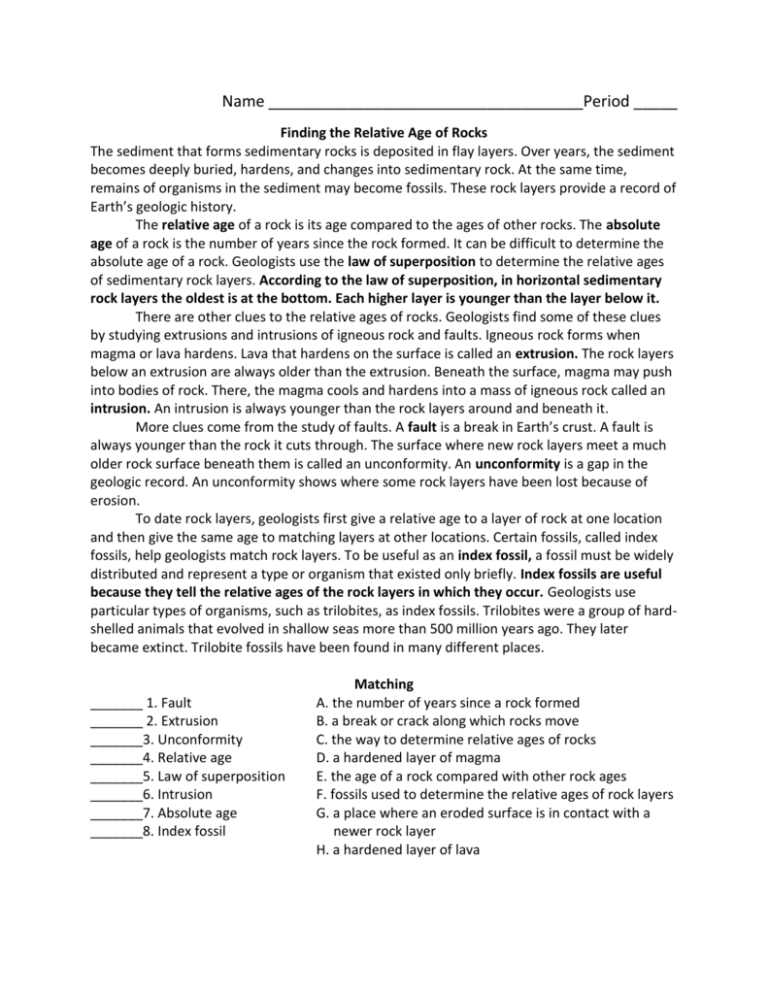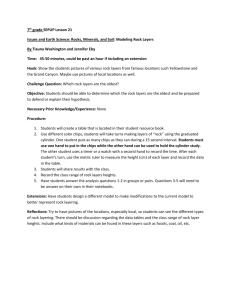Name _____ Finding the Relative Age of Rocks The sediment that
advertisement

Name ____________________________________Period _____ Finding the Relative Age of Rocks The sediment that forms sedimentary rocks is deposited in flay layers. Over years, the sediment becomes deeply buried, hardens, and changes into sedimentary rock. At the same time, remains of organisms in the sediment may become fossils. These rock layers provide a record of Earth’s geologic history. The relative age of a rock is its age compared to the ages of other rocks. The absolute age of a rock is the number of years since the rock formed. It can be difficult to determine the absolute age of a rock. Geologists use the law of superposition to determine the relative ages of sedimentary rock layers. According to the law of superposition, in horizontal sedimentary rock layers the oldest is at the bottom. Each higher layer is younger than the layer below it. There are other clues to the relative ages of rocks. Geologists find some of these clues by studying extrusions and intrusions of igneous rock and faults. Igneous rock forms when magma or lava hardens. Lava that hardens on the surface is called an extrusion. The rock layers below an extrusion are always older than the extrusion. Beneath the surface, magma may push into bodies of rock. There, the magma cools and hardens into a mass of igneous rock called an intrusion. An intrusion is always younger than the rock layers around and beneath it. More clues come from the study of faults. A fault is a break in Earth’s crust. A fault is always younger than the rock it cuts through. The surface where new rock layers meet a much older rock surface beneath them is called an unconformity. An unconformity is a gap in the geologic record. An unconformity shows where some rock layers have been lost because of erosion. To date rock layers, geologists first give a relative age to a layer of rock at one location and then give the same age to matching layers at other locations. Certain fossils, called index fossils, help geologists match rock layers. To be useful as an index fossil, a fossil must be widely distributed and represent a type or organism that existed only briefly. Index fossils are useful because they tell the relative ages of the rock layers in which they occur. Geologists use particular types of organisms, such as trilobites, as index fossils. Trilobites were a group of hardshelled animals that evolved in shallow seas more than 500 million years ago. They later became extinct. Trilobite fossils have been found in many different places. _______ 1. Fault _______ 2. Extrusion _______3. Unconformity _______4. Relative age _______5. Law of superposition _______6. Intrusion _______7. Absolute age _______8. Index fossil Matching A. the number of years since a rock formed B. a break or crack along which rocks move C. the way to determine relative ages of rocks D. a hardened layer of magma E. the age of a rock compared with other rock ages F. fossils used to determine the relative ages of rock layers G. a place where an eroded surface is in contact with a newer rock layer H. a hardened layer of lava Look at the diagram on the right. List what happened in the diagram. Start with the first event and continue to the latest event. Describe the processes that occurred to create this specific landform. 1. 2. 3. 4. 5. 6. 7. 8. __________________________________________________________________ __________________________________________________________________ __________________________________________________________________ __________________________________________________________________ __________________________________________________________________ __________________________________________________________________ __________________________________________________________________ __________________________________________________________________ List two specific things that you can tell about the relative ages of the rocks in this picture. Give fossils as evidence: 1. ________________________________________________________________________ ________________________________________________________________________ 2. ________________________________________________________________________ ________________________________________________________________________ Look at the diagram above. List what happened in the diagram. Start with the first event and continue to the latest event. Describe the processes that occurred to create this specific landform. Include the type of rock in your description. 1. 2. 3. 4. 5. 6. 7. 8. _________________________________________________________________ _________________________________________________________________ _________________________________________________________________ _________________________________________________________________ _________________________________________________________________ _________________________________________________________________ _________________________________________________________________ _________________________________________________________________








